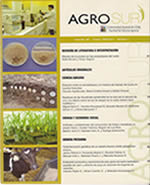Effect of the application of three strategies to improve degraded pastures on the hydraulic properties of the soil
Main Article Content
Abstract
Southern Chile is characterized by the use of degraded naturalized pastures for livestock production, affecting the physical characteristics of the soil that sustains them. The objective of this study was to determine the effect of three strategies to improve degraded pastures under intensive grazing for milk production on soil hydraulic properties. The pastures were established on Trumao soil (Duric Hapludand), and 4 treatments were carried out (control degraded meadow (DsF), degraded meadow + fertilizers (DcF), planted pasture of Lolium perenne L. (Lp) and Trifolium repens L. (Tr) + fertilizers (ScF) and a mixed sown meadow of L. perenne (Lp), T. repens L. (Tr), Dactylis glomerata L. (Dg), Bromus valdivianus Phil. (Bv) and Holcus lanatus L. (Hl) + fertilizers (McF)), distributed in
three complete blocks at random. Disturbed and undisturbed soil samples were taken from each plot and the water retention curves (pF) and pore-size distribution of the treatments were determined, as well as the hydraulic conductivity in saturated phase (Ks), the air permeability (Ka), the stability of the aggregates and the contact angle, and associated chemical parameters. The results obtained show only statistically significant differences in soil air capacity (PDR). The rest of the evaluated parameters did not show significant differences regarding the application of strategies to improve pasture, only trends, mainly due to the short time elapsed between the implementation of the trial and the measurements (2 years).

